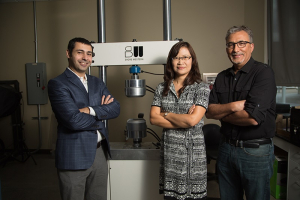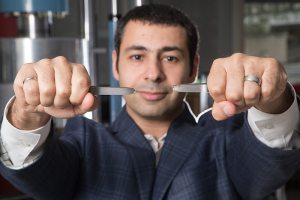Take a car trip from Houston and you’ll likely drive over one of the 50,000 bridges that span the great state of Texas. During your drive you probably never wondered if the weight limits on the bridges were accurate. But then, that’s why we have Mina Dawood, associate professor of civil and environmental engineering in the Cullen College.
That’s the way he thinks, and the Texas Department of Transportation (TxDOT) has taken notice, awarding him and two colleagues $260,000 over the next two years to assess bridges and bring them accurate load information. His co-principal investigators are Abdeldjelil Belarbi, professor of civil and environmental engineering, and Qianmei (May) Feng, associate professor of industrial engineering and Brij and Sunita Agrawal Faculty Fellow.
“TxDOT is by nature conservative,” said Dawood. “What we’re trying to do is allow them to safely increase the loads being carried by bridges and hopefully, in some cases, not need to post loads on bridges that are being load posted now.”
TxDOT regularly assesses its bridge inventory for safety and posts the safe load weight on older bridges that were built before the days of 18-wheelers and heavy intrastate traffic.
Historically conservative
When analyzing a bridge that was built almost a century ago, there’s a good chance the details of the material tests that were performed decades ago aren’t available, so engineers depend on guidelines set in The American Association of State Highway and Transportation Officials (AASHTO) Manual for Bridge Engineering (MBE).
“We believe AASHTO provides conservative guidance on material strength and, in reality, actual materials may have strengths measurably greater than the MBE guidance or what was specified in the original plans,” said Dawood. “If you have more accurate data about the strength of the materials in a bridge you would calculate more accurately the capacity of the bridge.”
While Dawood anticipates most load-posted bridges can take more weight, some bridges in Texas were built before World War II and environmental conditions may have hastened aging.
“On the one hand, the bridges are deteriorating, and on the other hand, we need to apply more load to the bridges on a day-to-day basis,” said Dawood.
Bridging the data gap
With TxDOT the UH group will visit different historical bridges being decommissioned to gather test samples. The samples may be collected from girders, braces, gusset plates, reinforcing bars in concrete, bolts or rivets – any steel part in the structure. Back at the Structural Research Laboratory, machinists will take the test samples and create pieces small enough to hold in your hand (called tension coupons) and stress testing on those pieces will begin. Machines will actually pull apart a tension coupon to note the exact load at which it ruptures.
Aside from test samples, the group will pull information from the TxDOT historical archives and explore existing literature. And then, Feng will take all the pieces of information to make sense of it.
“I will look at the strength of the materials versus the stress or loads, to see how much stress the bridge can take based on the material strength.” said Feng.
“We definitely need Dr. Feng’s expertise with statistics,” said Dawood. Out of a thousand or more pieces of data, she will conduct a statistical analysis and identify the appropriate material strengths to be used for load ratings based on the desired reliability of bridges.
Once the work is completed and delivered to TxDOT, there’s a good chance that state officials will have their hands full: traveling Texas, changing signs and bringing load posts up to date, the way Cullen College engineers determine appropriate.

